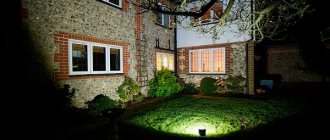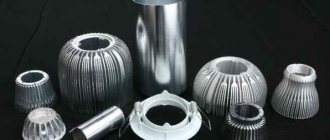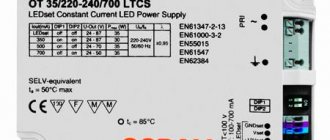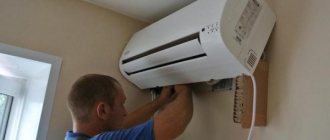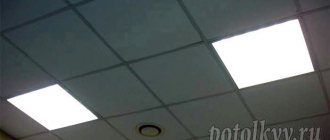Suspended ceilings in a modern interior can significantly save time and simplify the installation of electrical wiring throughout the facility. In addition, they are very aesthetically pleasing and flexible in design. Armstrong or Grilyato suspended ceilings are especially popular in the office segment. Smooth slabs of porous plasterboard are the calling card of almost every office space and not only the business segment. They make it easy to get to the mounting boxes and lamps built into them, add devices, and install additional communications such as the Internet, telephone, video surveillance. In this article we will talk about installing the Armstrong lamp and connecting it yourself.
Step-by-step instructions for dismantling the Armstrong ceiling
If you only need to replace the Armstrong suspended ceiling, or rather its slabs, then removing the old panels and installing new ones will not be difficult. It is enough to lift the panel in the cell, turn it diagonally and remove it from the ceiling structure.
In this case, there is no need to dismantle the lighting raster devices. It is enough to remove only the spotlights that are installed in the slabs to be dismantled. To do this, disconnect the device from the power supply, disconnect the wiring, and then remove the lamp from the stove.
If the Armstrong metal ceiling is dismantled, that is, the slabs are removed and the supporting frame is dismantled, then more large-scale and complex work awaits. Therefore, we will describe the disassembly process step by step and in more detail.
Tools and materials for work
Of course, all work can be carried out with a standard minimum set of tools, but it is better if you have everything necessary for dismantling. This way you can carry out the work faster and with less risk to yourself.
To dismantle the Armstrong suspended ceiling, stock up on the following materials and tools:
- screwdrivers;
- screwdriver;
- set of wrenches;
- putty knife;
- pliers;
- wire cutters;
- stationery knife;
- narrow nose pliers;
- insulating tape;
- stepladder or small scaffolding;
- safety glasses and gloves;
- polyethylene film.
Also prepare a rag to wipe off dust from the back of the slabs and profiles before storing.
Dismantling sequence
After preparing all the necessary materials and tools, you need to prepare the room itself. It is advisable to remove bulky furniture from it, which interferes with access to all areas of the ceiling surface. Cover what you decide not to remove with plastic wrap to prevent debris from getting on it.
After this, we carry out the work in the following sequence:
- First, we dismantle the blind ceiling slabs. Since all the panels are not attached to the frame, but are simply laid on the shelves of T-shaped profiles, dismantling the panels is not particularly difficult. It is enough to lift the panel up from the cell, turn it diagonally and, tilting it upside down, remove it from the ceiling metal structure.
- Similarly, we take out all the remaining slabs and store them horizontally in the corner of the room, because elements in good condition can be used for installation in another place.
- After removing the blank slabs, we proceed to dismantling the built-in spotlights. To do this, release the spring mechanism that holds the device in the slab and carefully remove the lamp down through the hole. We disconnect it from the electrical wires and insulate their ends with construction tape.
- To dismantle raster lamps, they are disconnected from the supply wires, reaching the back side of the unit through adjacent cells from which the blind plates have already been removed. After the device is disconnected from the power source, we wrap the ends of the wires with electrical tape, and remove the lamp by lifting it and turning it diagonally.
- After this, it remains to disassemble the frame. First, we remove short transverse profiles 0.6 m long. To do this, it is enough to remove them from the lock in the longitudinal slats.
- Then we dismantle the 1.2 m long longitudinal profiles, removing them from the lock on the supporting rails. But first you need to disconnect them from the ceiling suspensions on which these elements are suspended from the base surface. To do this, it is enough to loosen the tension of the suspension by opening the ears and remove the suspension hook from the groove on the profile.
- We remove the supporting rails in the same way. That is, we first disconnect the hangers, and then remove the slats, which are simply laid on the wall profiles and are not attached to them with any fastening devices.
- Next, you need to disconnect the ceiling hangers, on which all the frame elements are suspended from the base ceiling surface. To do this, use a screwdriver or screwdriver to unscrew the anchors or screws from the ceiling and remove the suspension rod.
- All that remains is to dismantle the wall profiles, which in cross-section resemble a corner. To do this, we unscrew the screws from the walls on which the slats are attached.
Carefully store all dismantled frame profiles in separate piles, sorting them by purpose. In the future, these slats can be used to install a new suspended ceiling in another room.
As you can see, dismantling a suspended ceiling yourself is not difficult. It is enough to stock up on all the necessary tools and devices and strictly follow the sequence of disassembling the structure.
Operating principle
The operating principle of an LED light bulb is represented as a series of transformations that ensure the glow of its constituent emitters. When supplying voltage to the base, it first goes to the driver, the purpose of which is to bring the high voltage to a form acceptable for LED lamps.
To briefly describe this method of energy supply, it is enough to refer to the following diagram:
In simple terms, her work can be presented like this:
- First, the alternating voltage is applied to the diode bridge, where it is partially rectified.
- The electrolytic capacitance that follows is designed to smooth out pulsations.
- After this, the fully rectified voltage is supplied to the controller that controls the operation of the LED lamp.
- From the electronic module it goes directly to the LEDs through an isolating pulse transformer.
Important!
When answering the often asked question: why is such an isolation needed, we will answer - its presence partially reduces the risk of injury from high voltage when working with a lamp base.
The principle of operation of a 12 Volt LED light bulb is much simpler, since to convert the voltage you will need a standard power supply and nothing more. And this, ultimately, reduces the cost of the entire product as a whole.
Connection diagram
To connect to the network, a standard 4x18 circuit is used. Recommendations that will help you carry out everything correctly using the technology:
Lamp connection diagram
- The wiring under the ceiling should be hidden in a corrugation, which is secured with ties. This will help prevent sagging and damage to fragile decorative boards.
- The distribution box should be placed near the lighting fixtures, and the power cable should be led from it to each lamp.
- Install light bulbs and reflectors after placing the lamp in its place.
- Connecting cables: connect neutral (blue) to the terminal block via the N connector, phase (white/red) - to terminal L.
Expert opinionAlexey BartoshSpecialist in repair and maintenance of electrical equipment and industrial electronics.Ask a question to an expertAdvice! If you need to connect more than 1 lamp, the cables for each of them are stripped, twisted in pairs (by color), and then connected to the terminal block.
Unique development
In the modern world, LED lamp models are in particular demand.
The LED is a unique development that has successfully taken root in the lighting market and has been able to displace many of its predecessors. The operating principle of this kind of lamps is based on the use of semiconductors that emit light. As a result of the application of this principle in production, it became possible to invent economical and long-lasting lighting devices. Lamps from the Armstrong line, being LED products, have all the advantages that are inherent in this type of lighting fixtures.
Features of ceilings
The Armstrong slatted suspended ceiling has its own design features, as well as the lamps suitable for it. Among the main features:
- Speed and ease of installation with minimal dust and dirt.
- You can do the installation yourself.
- Convenience of masking communications of any type and size. The ceiling can be lowered as much as required using special hangers.
- Easy access to each block.
- Elementary installation of a special lighting device instead of ceiling sections. In this case, wiring will not be a problem. The size of each ceiling section is 60x60 cm - it’s easy to lay new electrical communications.
Armstrong ceilings have an attractive appearance
Among the advantages of Armstrong ceilings and their lamps:
- Easy to install on any part of the ceiling. The size of the device is the same as the decorative cell; removing the ceiling element and installing a lighting device in its place will not take more than 1–2 hours.
- Uniform lighting. To do this, the devices are arranged in a checkerboard pattern. This helps eliminate dark areas.
- Adding new light sources without restrictions is carried out in the same way as replacing them with decorative ceiling elements.
- Easy access to wiring and fasteners.
- Each lamp has anti-vandal protection, which ensures the safety of light sources. In the case of mercury fluorescent lamps, this is a significant advantage.
- Lamps used for Armstrong ceilings can be mounted in suspended and plasterboard suspended ceilings. In the first case, the light element is only an LED. Installation in such ceilings has its own characteristics.
There are also disadvantages, the main one being the standard appearance. Consumers also note the high price of each individual lamp.
Choice for you
Built-in model
Today, lamps of the Armstrong 4x18 model are divided according to the installation method into the following types:
built-in Such lamps got their name due to the fact that they are mounted into the surface of the ceiling without protruding above it. Built-in models are actively used in offices, which is why they are also called “office lamps”. Suspended ceiling structures can support a large number of such lighting fixtures;
invoices. The peculiarity of such lamps is that they can be installed on any type of ceiling (regular or suspended). They can also be found in offices, but much less frequently.
In addition, Armstrong 4x18 may vary depending on the lighting element:
LED type
- LED. It is considered a more modern option. Such lamps can be combined in parallel or in series, forming lines. They have all the advantages that were described above;
- luminescent. Such lamps have a modular structure. Standard luminaires typically use four lamps. A mandatory element of the product is the presence of ballasts. This equipment may be electronic or electromechanical. But the latter have a significant drawback, which is the presence of a stroboscopic (pulsating) effect. It occurs when the lamp is turned on and over time leads to eye fatigue.
Office spaces today are often equipped with LED models. Thanks to them, there is a good luminous flux from the ceiling, absolutely harmless and pleasant to the human eye. As you can see, the most popular models for office ceilings are recessed Armstrong 4x18 LED lamps.
Ceiling preparation
Like other types of suspended ceilings, Armstrong completely hides the imperfections of the rough ceiling, so surface preparation consists of removing the old peeling coating. If the whitewash or paint adheres firmly to the ceiling, it does not need to be removed. In the event of detachment of individual sections or destruction of the plaster, fallen pieces of the old finish can damage the slabs, so it is better to remove them and seal the cracks and cracks with cement or alabaster putty.
Armstrong ceilings with soft slabs are afraid of water and, when wet, fall to the floor and break. Therefore, in rooms where water leaks are possible, it is necessary to waterproof the ceiling.
There remains a distance of 20-25 cm between the finished ceiling and the ceilings, in which sound and heat insulation materials can be placed. In this case, first install a frame made of a wooden block for fiber insulation boards, positioning it so that it is offset relative to the frame of the suspended ceiling. Lay the insulation and cover it with a vapor-permeable moisture-proofing film. When using polystyrene foam, it is attached directly to the sub-ceiling using glue and mushroom dowels.
List of sources
- potolokspec.ru
- 1posvetu.ru
- remontkvartiri.me
- centro-pol.ru
- KakPostroitDomic.ru
- www.defsmeta.com
Electronic ballast
All the shortcomings of the scheme described above stimulated research. As a result, an electronic ballast circuit was developed. It does not supply a network frequency of 50 Hz, but high-frequency oscillations (20-60 kHz), thereby eliminating the flickering of light, which is very unpleasant for the eyes.
One of the electronic ballasts is electronic ballasts
The electronic ballast looks like a small block with terminals removed. Inside there is one printed circuit board on which the entire circuit is assembled. The block has small dimensions and is mounted in the body of even the smallest lamp. The parameters are selected so that the start-up occurs quickly and silently. You don't need any more devices to work. This is the so-called starterless switching circuit.
Each device has a diagram on the back side. It immediately shows how many lamps are connected to it. The information is also duplicated in the inscriptions. The power of the lamps and their number, as well as the technical characteristics of the device are indicated. For example, the unit in the photo above can only serve one lamp. Its connection diagram is on the right. As you can see, there is nothing complicated. Take the wires and connect the conductors to the indicated contacts:
- Connect the first and second contacts of the block output to one pair of lamp contacts:
- serve the third and fourth to the other pair;
- supply power to the entrance.
Installation options for Armstrong lamps
The lamp body is a square metal panel with dimensions of 600x600 mm, or 595x595 mm, and a thickness of 25-60 mm. It has four surface mounting holes that allow you to mount the lamp to a vertical or horizontal surface. In rare cases, a suspended installation method is used, for which additional parts are used - cables or hangers. They are attached with one side to the same holes, and the other to the load-bearing surface.
Before you buy an Armstrong LED lamp, you need to decide on the method of its installation. With different thicknesses of the lighting fixture housing, different types of installation are used.
Surface-mounted and arranged installation is most often used for Armstrong lamps with a body 40 mm wide. Embedding occurs by simply placing the lighting fixture on the suspended ceiling frame. The lamp body fits into the cell freely, since they are the same in size.
Armstrong lamps with a body width of 25 mm are installed only in the built-in way due to the presence of hidden parts, namely the power supply, which is located in the inside of the lamp.
The Armstrong lamp is installed in the following way:
- Before installation, the diffuser is removed;
- The lamp body is inserted diagonally into the selected ceiling cell;
- The lamp in the niche is turned horizontally and aligned with the edges of the cell.
For complete clarity, we suggest watching a short video about the installation of Armstrong lamps:
And if, after watching the video, you still have doubts about installing Armstrong lamps yourself, our company’s specialists also provide such services. Phone number for contacting the installation department Vyacheslav.
You can view our assortment in the Armstrong lamp catalogue.
Safety precautions
The Armstrong ceiling lamp is an electric lighting device, so when connecting, you must follow safety precautions:
- Before touching cables and after installation, use the indicator to ensure there is no power.
- Do not connect yourself; in case of electric shock, first aid can be provided by a second person.
- Take care of grounding.
- Connect the power supply to the panel only after checking all insulation and correct connections.
- It is better not to establish a connection through twisting. This method is very unreliable.
- When working, use tools with plastic or rubber handles.
- If you do not have the skills to work with an electrician, it is better to entrust the connection to specialists; the prices for such work are quite affordable.
- Before working with electrical wiring, the cables are de-energized.
- the wires used for connection must be carefully insulated.
Stages of work
The entire process of performing work can be divided into several stages. Moreover, each of them can be performed in several ways and using different building materials. This manual discusses the simplest design of a suspended ceiling, which is produced according to generally accepted standards. For example, let's take the most common Armstrong ceiling.
Preparatory work
- First of all, you need to decide on the number of constituent elements. To do this, draw a ceiling on a sheet of paper to scale, which is divided into 60 cm cells. At the same time, they must be arranged so that there are as few small scraps as possible. If this is not possible, then they are placed on the far side of the room.
- Then add all the sides to get the length of the perimeter. It is necessary to order a perimeter corner according to it.
- By adding the length of the longitudinal sections inside the perimeter, we get the footage of the load-bearing profiles, and according to the number of remaining lines, we order transverse profiles for the suspended ceiling.
- Suspensions should be purchased at the rate of one piece per meter of supporting profile.
- The number of panels should be taken according to the number of resulting cells.
- After the calculations have been made, the ceiling is cleaned and treated with antibacterial primer.
Assembly option
This amount of material and the technology for installing a suspended ceiling are recognized as the most optimal and reliable. It is used all over the world for premises of any size and purpose.
Perimeter installation
- First, it is necessary to mark the perimeter on the walls to the level of the intended ceiling placement. To do this, you can use a laser level or a water level. Also, for convenience, a thread using blue is used.
- The result should be a straight line running along all the walls of the room. The corner should be installed according to it. This is done using impact dowels.
Drawing a line on the wall using a water level and blue thread
Installation of supporting and cross profiles
- The profile is mounted in accordance with a pre-made drawing that was used in the calculations.
- To do this, a special suspension is attached to the ceiling, adjusting it to the required distance.
- We attach a supporting profile to it, the ends of which are placed at the corner of the perimeter or connected to another material of the same type.
Suspension
After the second supporting profile is installed, we connect it to the first using crossbars. At the same time, the technology for installing ceilings involves the use of special locks, the hooks of which are located at the ends of the profile, and the grooves under them are at a short distance from each other along the entire length.
Additional work and installation of equipment
After the frame is completely assembled, you can begin laying out communications and utility networks. All wires are located along the walls, and only the lighting systems of a given room are led directly to the installation site of the devices. For ease of installation, you can temporarily remove several transverse profiles, which will later be installed in place.
Modern technology for manufacturing suspended ceilings involves the placement of special lamps for suspended ceilings in sections. They are attached in the same way as decorative panels, which are subsequently connected to the electrical network.
Installation of panels and lighting
Light flow
We measure the luminous flux in a photometric cube manufactured in accordance with GOST. It is designed to measure the luminous flux of large outdoor floodlights and Armstrong LED ceiling luminaires. The cube is calibrated with reference light sources. Before measurements, a standard is always set first and accuracy is checked, then samples are checked. This check allows you to avoid inaccuracies and deviations.
The light flux is too high in 6 models, only in Lezard it is 7% less than normal. Typically this result is due to the matte diffuser, which loses 25% to 35% of the light. And the characteristics indicate the luminous flux for a prism, microprism or crushed ice diffuser.
Regarding the Foton LED ceiling lamp, I suspect that it is not working properly, the result is suspiciously low. Therefore, SmartBuy wins again, it is the cheapest.
| — | Declared light flux | Light flux measured | Efficiency Lm/W | Difference in % from declared |
| LuxLed | 4100lm | 3000 | 67 lm/W | -27% |
| LedRay | 4400lm | 3830 | 72 lm/W | -13% |
| Foton | 3400lm | 2240 | 57 lm/W | -34% |
| Smartbuy | 3300lm | 2240 | 70 lm/W | -32% |
| Lezard | 3400lm | 3150 | 70 lm/W | -7% |
| Era | 3300lm | 2780 | 75 lm/W | -15% |
| SVO | 3200lm | 2560 | 64 lm/W | -20% |
What's good and what's bad about Armstrong?
In addition to ease of installation and low cost, the Armstrong ceiling also provides excellent sound and heat insulation. The inter-ceiling space is vast; lamps and communications are conveniently placed in it. Access to them and ceiling repairs are easy and do not require tools.
However, the Armstrong ceiling is not very strong and does not actually protect against leakage from above, and if the slabs are fibrous, then it itself is irrevocably deteriorated by moisture. It is impossible to obtain curved configurations with Armstrong, and the diagonal design of the ceiling negates all its simplicity and cheapness: only a highly paid master will undertake such work, and it will require a lot of time.
In terms of the height of the room, the Armstrong ceiling “eats off” at least 250 mm, so it can be found extremely rarely in city apartments. Nevertheless, the Armstrong ceiling is used not only in offices and supermarkets, as intended by its creators, but also in restaurants, entertainment centers, etc. But in such cases, Armstrong is no longer an economic, but a design decision (see picture above).
Calculation of the number of LED panels per room
To calculate the number of LED panels required for comfortable lighting of a particular room, use the table.
It shows the total power of lamps per 10 m2 of illuminated room. And also the dependence of these indicators on the type of room itself: bedroom, bathroom, living room, kitchen, etc.
For example, for a kitchen with an area of 10 m2 you will need LED panels with a total power of at least 40 W. If these are 10 watt models, then 4 of them will be required.
At the same time, do not forget about the color of the glow: cold – warm – neutral.
It is not suitable for all rooms. And when used in some, it can even cause vision problems.
You can select high-quality lamps for the size you need, check prices and order them for home delivery here.
Installation procedure
When installing a frame under “Armstrong” or “Grigliato”, it is necessary to provide a minimum allowable distance between the frame slats and the ceiling of 20 cm. Otherwise, installation of the lamp will have to be done simultaneously with the installation of the frame, and this method does not allow easy access and simple maintenance, and therefore not acceptable.
The Armstrong lamp (pictured below) is easily recognizable; it is a square-shaped design with four light emitters (lamps), covered with a scattering film or a reflective grille.
As a rule, installing Armstrong lamps does not cause problems, since the size of the cell window and the dimensions of the devices are the same. When inspecting the structure of a suspended ceiling, it is necessary to visually familiarize yourself with the suspension elements and their location, since there are cases of “fierce” savings by installers.
It is acceptable when there is one ceiling mount for two cells, and at least four for a square of four cells. Otherwise, during installation it is necessary to additionally fasten the lamp to the ceiling to minimize its weight on the suspended structure.
Before installing the Armstrong lamp, the diffuser is removed from the lighting fixture, leaving the housing with the starting equipment. In this state it is easier to manipulate during installation. A lamp is inserted into the selected cell at a diagonal angle. After it is completely behind the ceiling, it is turned horizontally and combined with the cell.
You can learn how to install a lamp in a suspended ceiling from this video:
Correct housing installation
https://youtube.com/watch?v=YGExpbtJHLY
In addition, we recommend looking at how to evenly position Armstrong-type lamps on the ceiling:
Using a Laser Level
In addition to raster ones, built-in or point lighting sources are also used; holes are cut in decorative slabs for their placement. This solution is well suited for small rooms with low ceilings, or places that require additional light flow.
To install the Armstrong lamp under a suspended ceiling, you must first install special fittings for attaching lighting fixtures. Because after installing a stretch ceiling, it will be almost impossible to correct anything, as is the case with the Armstrong or Grilyato modular ceilings, where the number and placement of elements easily varies.
Advantages of LEDs
In addition to low energy consumption, there are other advantages:
- environmental Safety;
- light weight and size;
- no ultraviolet radiation;
- instant tanning;
- when installed in the cabin, the air does not heat up;
- long service life (if the lamp is of high quality);
- ability to choose almost any color temperature.
Disadvantages of LEDs
Most consider the high cost to be the main disadvantage.
There are other disadvantages:
- decrease in efficiency during operation;
- the need for an additional cooling system;
- unmaintainability (if one element fails, the device must be replaced).
In the absence of a special control system, the intensity of the glow decreases.
Legal points
By law, LED car lamps cannot be installed on all vehicles.
There is no penalty if:
- the car was produced with LED lighting;
- the car has halogen lighting, but the design does not interfere with the installation of LED lighting;
- After replacing the headlights, a certificate was received certifying the safe operation of the vehicle.
In all other cases, the Code of Administrative Offenses provides for a fine of 500 rubles.
Varieties
Armstrong ceiling lamps are divided according to the type of light source into:
- LEDs are gaining popularity due to their efficiency, durability and ease of use. Ice strips are built into the body and do not require replacement.
- Luminescent - using gas-discharge light sources. Such devices are equipped with ballasts (ballasts), which, in turn, are divided into electromechanical and electronic. Electromechanical ballasts have a big disadvantage - they create pulsation, which negatively affects human health, spoils vision, and increases fatigue. Electronic ballasts increase the service life of fluorescent lamps, do not have a detrimental effect on the visual apparatus and are more economical compared to electromechanical ones.
Example of gas-discharge lamps: LPO (fluorescent ceiling lamps for public buildings) with one or two tubular lamps with a diameter of 26 mm and a length of 0.6 or 1.2 m; LVO (fluorescent recessed for public buildings) with two or four tubular lamps of the same size.
A large number of consumers prefer fluorescent lamps due to their low cost. But an LED lamp will be a promising purchase for the following reasons:
- The service life of fluorescent lamps, of which there are 4 18 V pieces in the lamp, is 10 thousand hours (they will have to be replaced during operation), and for LED lamps - 50 thousand.
- Diodes have lower energy consumption; the power of such a lamp is 45 W, in contrast to 120-watt gas-discharge lamps.
- The diode device provides bright illumination due to the downward flow directed 120 degrees. With luminescent, dispersion occurs at 360 degrees. At the same time, the LED is economical, turns on instantly, without going through the flickering stage.
- LED sources are safer than gas-discharge ones. The latter contain mercury vapor in the flask and, when destroyed, poison the environment and also emit ultraviolet radiation. Diodes do not make noise and do not emit thermal energy.
How to choose?
In order to receive enough light, when choosing such a lamp you need to pay attention to the technical characteristics. As for energy consumption, one fluorescent lamp will be 5 times more economical compared to an incandescent lamp, but its energy consumption also goes to the ballast system
If we talk about LEDs, they are 2 times more economical compared to fluorescent ones.
It is also worth paying attention to the service life. For the type of lamps under consideration this is:
- Luminescent - 7 thousand hours.
- LED - 50 thousand hours, but this is only possible if negative factors are excluded. For example, to ensure a stable voltage and eliminate “clattering”, that is, it is cheaper not to turn off such lamps at all.
Original LED glow When choosing, you also need to pay attention to the intended placement of the lighting panels. Often this is a checkerboard pattern, this way it is possible to cover all zones and make the lighting holistic and bright
Armstrong lamps: pros, cons, main characteristics
Before you buy Armstrong ceiling lamps, you should familiarize yourself with their main features in as much detail as possible and study the positive and negative qualities of the structures. It should be noted that lamps of this type are considered one of the most popular products on the Russian market. This demand is due to the high performance properties of the product, as well as its cost-effectiveness. The use of such lamps allows you to save significant money, since, unlike conventional incandescent lamps, Armstrong lamps consume several times less electricity. Such savings will be especially noticeable if lighting fixtures are used in large quantities in large rooms.
I would like to consider the advantages of Armstrong lamps in more detail:
- Among the design elements of the lamps there is a special anti-vandal protection, which also serves as a diffuser. Anti-vandal protection not only protects LEDs from damage that may occur as a result of external mechanical influences, but also contributes to the uniform dispersion of light throughout the room.
- Built-in Armstrong ceiling lights illuminate the room quite well. The maximum number of LEDs in such designs is 32, which allows you to get an excellent level of illumination.
- The luminaires are also equipped with an aluminum cooling radiator, the role of which is to protect the LEDs from overheating and extend their service life. We add that the service life of LEDs reaches 50,000 hours of continuous use.
- During their operation, Armstrong lamps make absolutely no noise.
- If the voltage in the network sharply decreases or increases, lighting fixtures of this type do not flicker.
- LED lamps do not contain mercury, therefore they are considered environmentally friendly and safe. In addition, there will be no problems with the disposal of lamps that have expired.
- The light from such devices is diffused and uniform, which allows you to well illuminate every corner of the room.
- The positive properties of such lamps also include the ease of installation. If there is a need to remove the structure in order to get to the communications laid behind it, dismantling is quite easy.
As you can see, lamps of this type have a number of positive qualities. But we must not forget about the shortcomings of the designs; let’s consider them in more detail:
- The price of Armstrong built-in ceiling lights is quite high. Those who decide to purchase them are those who see real money savings in the case of using such devices. For example, owners of large premises will be able to save significant amounts of money on electricity bills. But in the case of small rooms or spaces where artificial light is rarely used, the cost of Armstrong lamps will not always be justified.
- The variety of types and shapes of such devices is small, so it is unlikely that they will fit into any design. Armstrong lamps are best suited for rooms designed in a strict minimalist style.
- The light emitted by such devices has a cold spectrum, so Armstrong lamps will not add coziness to the room. In addition, cold lighting with prolonged exposure is a little tiring.
- After about 3-4 years of operation, some of the LEDs may become dimmer or even fade away, so over time they will have to be replaced with new ones.
Popular LED manufacturers
Many manufacturers are already producing LED lamps for headlights, but it is better to opt for time-tested ones. You shouldn’t save money and buy cheap fakes; it’s better to buy a high-quality lamp from a reputable manufacturer that guarantees both a bright glow and a long service life.
Among the popular manufacturers of ice lamps for headlights, the following are clearly in the lead:
NIGHTEYE company. One of its latest products is H4 LED lamps for NIGHTEYE H4 headlights. The price in this case is justified by the quality one hundred percent. The kit initially comes with two light bulbs, each with a brightness of 4000 lumens. And the use of lighting sources is possible on headlights of any configuration. Also a huge plus is the nominal operating time, which is equal to 100,000 hours. In fact, this mark was not achieved, but in practice the performance indicators are close to nominal. hlxg company. Users respond positively to the entire line of diode car headlights. The most common LED lamp from this company is H4 50 W. The fact is that the design of the lamp itself corresponds to a huge number of car headlights and installation is quite simple. But you need to take into account that you should not install these ice bulbs on headlights with lensless deflectors, since the illumination level will not be able to achieve the effect of 6000 K. But with lenses, the effect will be completely opposite - on the most unlit track with these diodes, any driver will feel confident. Rated for 30,000 hours. DXZ has also managed to establish itself on the positive side. For example, a set of DXZ BrightLux H4 ice lamps is distinguished by decent brightness: with a power of 45 Watts, the real brightness reaches 6000 Lumens and the color temperature reaches 6500 K. The lamp body is made of aircraft aluminum, which can provide maximum protection from moisture and dust. Service life is rated for 50,000 hours. Auxmart has long been a favorite of many drivers. For example, Auxmart H7 headlight lamps are designed to solve all problems with poor road lighting. Each element is capable of producing 4000 lm and has good focusing on the road surface. When switching from high beam to near beam, the directional beam is perfectly scattered and collected, and the boundaries are clearly visible. And according to many drivers, the quality of the headlights does not affect the brightness of the lamps.
But in the case of these headlights, special attention must be paid to brightness due to the fact that the color temperature of 6500 K can blind drivers, which often requires additional adjustment. ZDATT company. Particular attention should be paid to the ZDATT H7 COB headlight kit
In this case, a great advantage is given to increasing operating temperatures. The lower limit remained -40, but the upper limit was increased from 80 to 150 degrees. This fact allows us to state with absolute certainty that overheating is not possible when the cooling fans are running. The power of the set is 80 watts, with each lamp producing 4000 lm with a temperature of 6000 K. Designed for 30,000 hours.
Installation
It is very easy to install the Armstrong system with your own hands, 10-15 sq. m of covering can be installed in 1 day.
For assembly you will need the following tools:
- laser or bubble level;
- roulette;
- drill or hammer drill with concrete drill;
- Phillips screwdriver or screwdriver;
- metal scissors or grinder for cutting profiles;
- screws or anchor bolts.
The good thing about the elements of such ceilings is that they are universal; the parts from any company are identical and are made up of guides and adjustable suspensions with the same fastenings. All profiles, except for the corner ones for walls, do not require self-tapping screws or self-tapping screws; they are connected using their own fastening system. Therefore, to install them, you do not need extra tools and materials.
Installation begins with securing the corner guides around the perimeter. They need to be fastened with the shelves down so that the top edge runs exactly along the previously marked line. Self-tapping screws with dowels or anchor bolts are used, pitch 50 cm. In the corners, where the profiles join, they are cut off a little and bent.
Then you need to screw the fastening units into the old ceiling and hang all the metal hangers on them by the upper hinges. The layout of the fasteners should be such that the maximum distance between them does not exceed 1.2 m, and from any wall - 0.6 m. In places where heavier elements are placed: lamps, fans, split systems, additional hangers must be fixed, at some offset from the location of the future device .
Then you need to assemble the main guides, which are attached to the hooks of the suspensions in special holes and hung on the shelves of corner profiles around the perimeter. If the length of one guide is not enough for the room, then you can build it up from two identical ones. The lock at the end of the rail is used as a connector. After collecting all the profiles, they are adjusted horizontally using a butterfly clamp on each hanger.
Next you need to assemble the longitudinal and transverse slats. They all have standard fasteners that fit into slots on the side of the guides. After complete installation of the frame, its horizontal level is checked again for reliability.
Before installing mineral slabs, you must first install lamps and other built-in elements. This makes it easier to pull the necessary wires and ventilation hoses through the free cells. When all the electrical appliances are in place and connected, they begin to secure the plates themselves.
Blind mineral slabs are inserted diagonally into the cell; lifting and turning, you need to carefully lay them on the profiles. You should not put too much pressure on them from below; they should fit effortlessly.
During subsequent repairs, installation of new lamps, fans, laying cables or decorative panels, the laid slabs are simply easily removed from the cells, and after the work is also placed in their place.
Is it necessary to change fluorescent light bulbs to LED lamps?
Today we can confidently say that LED light bulbs of any form factor are superior to their fluorescent counterparts in almost all respects. Moreover, LED technologies continue to progress, which means that products based on them will be even more advanced in the future. To confirm the above, a comparative description of two types of tubular lamps is given below.
T8 fluorescent lamps:
- MTBF is about 2000 hours and depends on the number of starts, but not more than 2000 cycles;
- light spreads in all directions, which is why they need a reflector;
- gradual increase in brightness at the moment of switching on;
- the ballast (ballast) serves as a source of network interference;
- degradation of the protective layer with a decrease in luminous flux by 30%;
- The glass flask and the mercury vapor inside it require careful handling and disposal.
T8 LED lamps:
service life is at least 10 thousand hours and does not depend on the on/off frequency; have a directional luminous flux; instantly turns on at full brightness; the driver does not affect the power grid; loss of brightness does not exceed 10% over 10 thousand hours; have significantly lower power consumption; completely environmentally friendly.
In addition, T8 LED lamps have twice the light output with equal energy consumption, are less likely to fail and have a manufacturer’s warranty. The ability to place different numbers of LEDs inside the bulb allows you to achieve an optimal level of illumination. This means that instead of a T8-G13-600 mm 18 W fluorescent lamp, you can install a 9, 18 or 24 W LED lamp of the same length.
The abbreviation T8 indicates the diameter of the glass tube (8/8 inch or 2.54 cm), and G13 is the type of cap indicating the pin spacing in mm.
Having weighed all the pros and cons, we can conclude that converting a fluorescent lamp to an LED light bulb is completely justified, both from a technical and economic point of view.
Before moving on to upgrading the lamp by replacing T8 fluorescent lamps with LED lamps, you first need to properly understand the circuits. All fluorescent lamps are connected in one of two ways:
based on ballasts, which include a choke, starter and capacitor (Fig. 1);
Installation process
The minimum distance between the level of the finished Armstrong ceiling and the rough base is 20 cm; less is not allowed, since standard raster lamps cannot be built in. Before installation, you should check whether there are additional reinforcing hangers in the areas where the luminaires are installed.
It is allowed if there is 1 fixture on 2 cells for the lamp, but each individual square must have 4 hangers. If the performers saved money, then during the installation of the device they should additionally fix it to the rough ceiling using special suspension cables. Due to this, it will be possible to reduce the pressure on the suspended structure of the slatted ceiling.
Before fixing the lamp, you should remove the lamps, reflectors, and lenses from it; only the starting equipment remains on the body. Such manipulations will help reduce the weight of the lamp, and you can install it yourself. Next, the frame is placed in the cell and combined with it like a puzzle element.
If non-standard lighting fixtures are mounted, either spotlight or suspended, then a hole is cut out for them in the decorative slab and the device is inserted there, similar to installing them in plasterboard suspended ceilings.
troubleshooting
Kitchen lighting options with suspended ceilings
Cracks in the socket may appear due to mechanical action (shocks, falls, vibrations) on the lamp. Elements need to be changed. To do this, turn off the electricity, remove the lamp and socket. The wires need to be cleaned a little and inserted into the terminals of the new cartridge
When working, it is important not to mix up the wires
The ballast in the lamp may break. It regulates the amount of voltage supplied. If the failure is related to the ballast, it will be cheaper to buy a new lamp. The malfunction can be determined by the hum of the device.
A broken fuse or power supply is recognized by flickering. If the light blinks, you need to reset the power by turning the switch on and off. If this does not help, you will have to change the block.
Attaching the chandelier using a mounting strip
As a rule, chandeliers come in two types:
- Equipped with a fastening strip. The bar is mounted on the ceiling, and then the chandelier is attached directly to it.
- Attached to a ceiling hook that is securely screwed into the ceiling. We will try to cover in more detail how to attach a chandelier to the ceiling surface, using each of the indicated methods.
Mounting the mounting strip
Fastening the ceiling chandelier begins with installing the fastening strip to the surface:
- To begin with, they try on the chandelier in the place where it is supposed to be installed in the future. The decorative element of the chandelier, covering the mounting point and wires, must fit tightly, without gaps or play, to the ceiling.
- If there is a hook from an old lamp at the installation site, bend it to the ceiling so that it does not interfere. It is not recommended to cut off the old hook, since your next chandelier may be mounted using it, and you will need to re-install this type of fastener, which is impractical.
- Make markings for fastening the mounting strip and install fasteners for the chandelier on the surface. To do this, apply the strip to the ceiling in such a way that it does not interfere with the wiring connection, and use a pencil to mark the mounting location. Next, drill holes and drive dowels into them. Then they attach the plank to the ceiling using screws (read further: Attaching a chandelier to a suspended ceiling).
A chandelier mounting strip correctly attached to the ceiling will be the key to the reliability of the installed lighting fixture.
Connecting electrical wiring
Before attaching the chandelier to the ceiling surface, it is necessary to connect the power supply wires provided in it to the power system of the house. Before connecting the chandelier, it is imperative to turn off the power to the house wiring and make sure there is no voltage using an indicator.
The rules for connecting a chandelier to the electrical network are as follows:
- If there is a single-key switch, the ceiling wiring under the chandelier usually consists of two or three wires - phase, neutral and optionally a ground wire. The presence of a grounding wire often depends on the time the house was built - in Soviet times such a wire was extremely rarely provided.
- It is necessary to determine the purpose of each wire, both among the ceiling ones and among those available in the chandelier. The phase wire is usually hidden in black, brown or red insulation, the neutral wire in blue, and the ground wire in yellow-green.
Connecting the chandelier wires to the electrical network must be done with the power supply turned off and in accordance with electrical regulations
Regardless of the presence of color or other markings on the wires in the ceiling, they should be tested with an indicator screwdriver. To do this, you will need to turn on the current supply for a while. You should touch the exposed part of the wires one by one and record the indicator value. The indicator that lights up will indicate the phase wire; if the indicator does not light up, it means the wire is neutral.
- Wires of the same type are connected through terminals, and if there is a wire “without a pair” (grounding), it is isolated and moved to the side. After this, you can continue further attaching the chandelier to the ceiling.
- A two-key switch assumes the presence of two-phase wires in the ceiling (see Ceiling lamps: select the one you need). They are connected respectively to the phase wires of the chandelier of the 1st and 2nd groups (if any). The neutral and ground wires are connected in the same way as in the first case.
What needs to be changed?
By carefully looking at the diagrams, even an inexperienced electrician will understand how to connect an LED lamp instead of a fluorescent one. In a luminaire with ballasts, you need to perform the following steps:
- Turn off the circuit breaker and make sure there is no voltage.
- Remove the protective cover, gaining access to the circuit elements.
- Remove the capacitor, inductor, and starter from the electrical circuit.
- Separate the wires going to the cartridge terminals and connect them directly to the phase and neutral wires.
- The remaining wires can be removed or insulated.
- Insert a T8 G13 lamp with LEDs and perform a test run.
The contacts in the form of pins for connecting the T8 LED lamp are marked on its base with the symbols “L” and “N”.
Converting a fluorescent lamp with electronic ballast is even easier. To do this, just unsolder or cut with wire cutters the wires going to and from the ballast. Then connect the phase and neutral wires to the wires of the left and right sockets of the lamp. Insulate the connection point, insert an LED lamp and apply supply voltage.
It is much easier to install and connect a T8 LED lamp in Philips branded lamps. The Dutch company has made the task as simple as possible for its consumers. To install an LED lamp with a length of 600 mm, 900 mm, 1200 mm or 1500 mm, you will need to unscrew the starter and screw in the plug supplied in the kit in its place. In this case, there is no need to disassemble the lamp body and remove the choke.
When choosing a T8 G13 LED lamp, you should pay attention to the design of the base. It can be rotary or have a rigid connection to the body
Models with a rotating base are considered to be the most universal. They can be screwed into any converted light fixture, with either vertical or horizontal slots in the socket. And by adjusting the angle of the lamp, you can change the direction of the light flux.
https://rozetkaonline.ru/podkljuchenie-i-ustanovka/item/174-skhema-podklyucheniya-svetodiodnykh-lamp-vmesto-lyuminestsentnykhhttps://odinelectric.ru/osveshhenie/istochniki-sveta/kak-zamenit-lyuminestsentnuyu-lampu- na-svetodiodnuyuhttps://svetosmotr.ru/kak-peredelat-svetilnik-dnevnogo-sveta-v-svetodiodnyj/https://strojdvor.ru/elektrosnabzhenie/zamena-lyuminescentnyx-lamp-v-svetilnikax-na-svetodiodnye/https: //ledjournal.info/vopros-otvet/zamena-ljuminescentnyh-lamp-na-svetodiodnye.html
